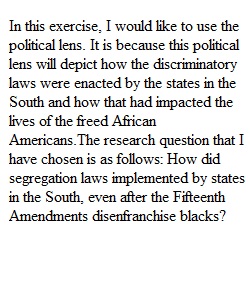


Q Overview: The short response activities in the webtext throughout this course are designed to show your understanding of key concepts as you engage with course content. Prompt: During the fifth week of the course, you will respond to several questions in the webtext as you complete each learning block. At the end of Module Five, you will review your answers to these questions and ensure that you have responded to each question. It is important that you answer each question, otherwise, the words “[no response]” will appear in brackets when you submit the assignment. The questions and their original locations in the webtext are listed in this table in case you want to refer back to the reading as you edit, but you can edit your responses to all the questions directly in Module Five: Analyzing History, learning block 5-4 (page 5) in the webtext, before exporting to Word for submission to your instructor in the learning environment. Module Five: Analyzing History, Learning Block 5-1 (page 1): • Question 1: In the space below, specify which historical lens you would like to use for this exercise. • Question 2: Next, formulate a research question about the civil rights movement (historical time from 1954–1968), using the lens you have chosen. Module Five: Analyzing History, Learning Block 5-1 (page 2): • Question 3: First, go back and review the research question you developed in Step 1. For Step 2, first name two different primary sources that you might use to answer that question. Be as specific as you can. Your primary sources should be found using the Shapiro Library. • Question 4: Next, name two different secondary sources you could use to answer your research question. Again, be as specific as you can. Your secondary sources should be found using the Shapiro Library. Module Five: Analyzing History, Learning Block 5-1 (page 3): • Question 5: Construct a thesis statement that provides an answer to the research question you posed in Step 1. Base your response on the historical evidence that has been presented in this course so far, as well as any research you may have done on your own. Module Five: Analyzing History, Learning Block 5-3 (pages 2–3): • Question 6: Name three specific historical events that can be considered contributory causes of the passage of the Voting Rights Act. Briefly explain why you believe each of these events contributed to the passage of the Act. • Question 7: Based on what you read about the passage of the Voting Rights Act on page 1 of this learning block, name one event that was part of the course of this bill’s passage by Congress. • Question 8: Name three specific consequences caused by the passage of the Voting Rights Act. • Question 9: One of these scholars relied heavily on evidence about the substance of today's political debate. Which scholar was that? What sort of evidence did he use? • Question 10: One of these scholars relied heavily on evidence about the political process. Which scholar was that? What sort of evidence did he use? Module Five: Analyzing History, Learning Block 5-4 (page 5): • Question 11: 1. What is the topic of this essay? Does the author make it clear in the introduction? 2. What is the author’s thesis? 3. What kind of sources and evidence do you think the author will use to support his thesis?
View Related Questions